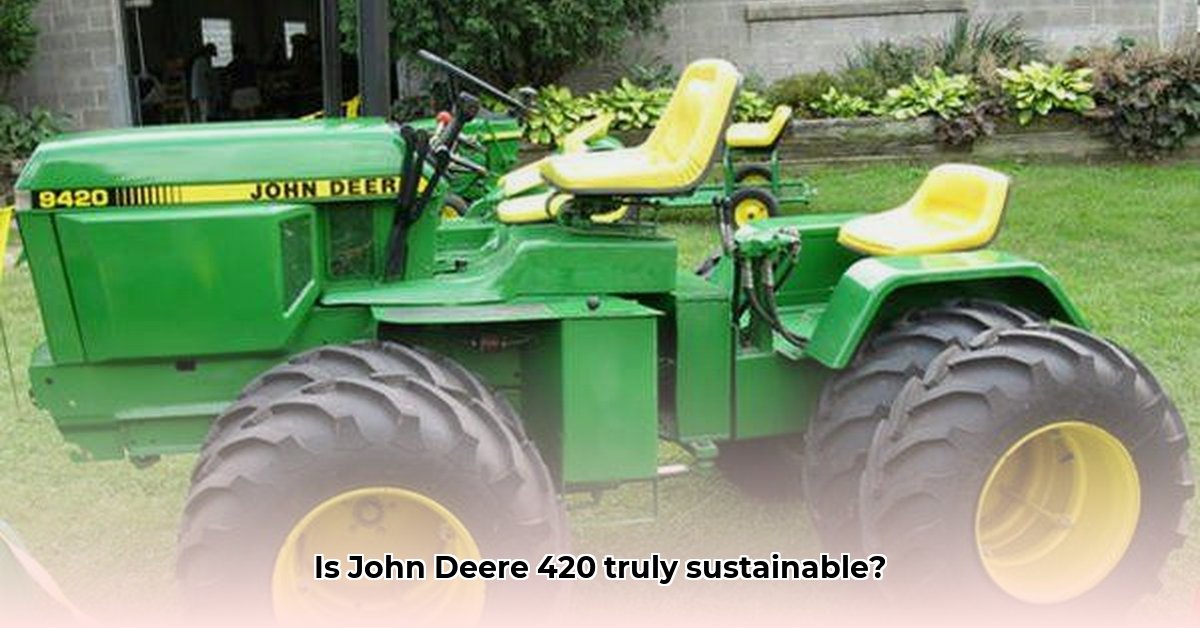
The John Deere 420, a workhorse from the 1980s and 90s, offers a compelling case study in sustainable product design. This review examines its sustainability from a lifecycle perspective, contrasting its simple, robust build with the complexities of modern lawn tractors. We'll explore its longevity, repairability, and potential for repurposing, ultimately assessing its environmental impact compared to today's options. Understanding the John Deere 420's strengths can inform future designs and consumer choices for a more sustainable lawn care future. For a similar analysis on a different model, see information on the John Deere 540.
Design and Features: Simplicity as Strength
The John Deere 420 stands in stark contrast to today's technologically advanced lawn tractors. Its design is refreshingly straightforward: fewer electronic components, readily accessible parts, and a robust mechanical build. This simplicity translates directly into enhanced sustainability. Fewer electronic failures mean longer operational lifespans and reduced waste. The ease of access to essential parts enables DIY repairs, minimizing landfill contributions and reducing the need for frequent professional service. This straightforward approach is a testament to a design philosophy prioritizing durability over fleeting technological advancements. Could this simplicity hold the key to a greener future in lawn care?
Sustainability Analysis: A Lifecycle Perspective
The John Deere 420's longevity significantly reduces its environmental footprint. Each year it remains operational represents a reduction in manufacturing demand, energy consumption, and carbon emissions. While precise data on its resource consumption during manufacturing is unavailable, its simple design suggests lower resource needs than modern counterparts. Owners often report decades of service, showcasing its durable construction. Its adaptability is also a plus; attachments such as snowplows or tillers extend its usefulness, further reducing the overall environmental impact. The repairability factor is crucial. Unlike modern tractors often requiring professional intervention for minor issues, the 420's straightforward mechanics allow for DIY repairs, substantially reducing waste. However, it’s important to note a significant data gap: comprehensive information on its manufacturing materials and disposal impact is lacking. This necessitates further research into historical manufacturing practices to fully quantify its sustainability profile.
Performance and Use: Reliable Operation
While lacking the advanced features of modern models, the John Deere 420 provided dependable performance for its time. Its 782cc engine offered sufficient power for most residential lawns. It's mechanical design largely avoided the electronic issues common in newer models, resulting in consistent operation. Its dependable nature translated to years of reliable service.
Long-Term Costs: Beyond the Initial Price Tag
The John Deere 420's true value lies in its longevity and repairability. The combination of lower repair costs and extended lifespan often results in a much lower total cost of ownership compared to replacing contemporary models every few years. This long-term cost-effectiveness directly contributes to its overall sustainability. Over a decade, cost savings easily outweigh any initial investment differences. This approach aligns with environmentally conscious practices by extending the life of a product and minimizing the need for frequent replacement.
Limitations: Acknowledging the Past
The John Deere 420’s limitations must be acknowledged. Stringent environmental regulations and detailed lifecycle assessments weren't the design priorities they are today. Its older engine likely doesn't meet current emission standards. The lack of comprehensive manufacturing data and disposal impact assessments prevents a complete quantification of its overall environmental impact.
Conclusion: Lessons from the Past, for the Future
The John Deere 420, a product of its time, offers valuable insights into sustainable product design, highlighting the importance of durability and repairability. Its simplicity speaks to a more environmentally conscious approach than many modern counterparts. The focus should be on creating durable, easily repairable equipment to minimize environmental impact throughout the product's lifecycle.
Call to Action: Toward a Greener Lawn Care Future
Consumers, manufacturers, and policymakers all need to prioritize sustainable lawn care practices. Consumers should prioritize durable, repairable equipment. Manufacturers should emphasize longevity and design for recyclability. Policymakers should promote incentives for sustainable manufacturing and responsible disposal methods. A collective effort, guided by learnings from machines like the John Deere 420, is essential for a greener future.